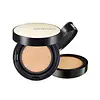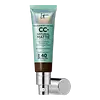Jung Saem Mool Essential Skin Nuder Cushion Versus IT Cosmetics CC+ Cream Natural Matte Foundation SPF 40
What's inside
What's inside
 Key Ingredients
Key Ingredients

 Benefits
Benefits

 Concerns
Concerns

 Ingredients Side-by-side
Ingredients Side-by-side

Water
Skin ConditioningCI 77891
Cosmetic ColorantCyclopentasiloxane
EmollientEthylhexyl Methoxycinnamate
UV AbsorberTrimethylsiloxysilicate
EmollientEthylhexyl Salicylate
UV AbsorberGlycerin
HumectantButylene Glycol
HumectantPEG-10 Dimethicone
Skin ConditioningCetyl Ethylhexanoate
EmollientNiacinamide
SmoothingPentylene Glycol
Skin ConditioningTrisiloxane
Skin ConditioningCI 77492
Cosmetic ColorantDimethicone
EmollientHydrogenated Coconut Oil
EmollientCaprylyl Methicone
Skin ConditioningPolypropylsilsesquioxane
Vp/Hexadecene Copolymer
Isododecane
EmollientMagnesium Sulfate
Acrylates/Dimethicone Copolymer
Skin ConditioningDisteardimonium Hectorite
StabilisingCetyl PEG/PPG-10/1 Dimethicone
EmulsifyingStearic Acid
CleansingAlumina
AbrasiveAluminum Hydroxide
EmollientSynthetic Fluorphlogopite
Triethoxycaprylylsilane
Ethylhexylglycerin
Skin ConditioningDimethicone Crosspolymer
Emulsion StabilisingAdenosine
Skin ConditioningTrisodium Ethylenediamine Disuccinate
Pentaerythrityl Tetra-Di-T-Butyl Hydroxyhydrocinnamate
AntioxidantPhenoxyethanol
PreservativeParfum
MaskingCI 77491
Cosmetic ColorantCI 77499
Cosmetic ColorantMica
Cosmetic ColorantWater, CI 77891, Cyclopentasiloxane, Ethylhexyl Methoxycinnamate, Trimethylsiloxysilicate, Ethylhexyl Salicylate, Glycerin, Butylene Glycol, PEG-10 Dimethicone, Cetyl Ethylhexanoate, Niacinamide, Pentylene Glycol, Trisiloxane, CI 77492, Dimethicone, Hydrogenated Coconut Oil, Caprylyl Methicone, Polypropylsilsesquioxane, Vp/Hexadecene Copolymer, Isododecane, Magnesium Sulfate, Acrylates/Dimethicone Copolymer, Disteardimonium Hectorite, Cetyl PEG/PPG-10/1 Dimethicone, Stearic Acid, Alumina, Aluminum Hydroxide, Synthetic Fluorphlogopite, Triethoxycaprylylsilane, Ethylhexylglycerin, Dimethicone Crosspolymer, Adenosine, Trisodium Ethylenediamine Disuccinate, Pentaerythrityl Tetra-Di-T-Butyl Hydroxyhydrocinnamate, Phenoxyethanol, Parfum, CI 77491, CI 77499, Mica
Water
Skin ConditioningDimethicone
EmollientIsododecane
EmollientEthylhexyl Salicylate
UV AbsorberButylene Glycol
HumectantSilica
AbrasiveCetyl PEG/PPG-10/1 Dimethicone
EmulsifyingGlycerin
HumectantIsohexadecane
EmollientPhenylbenzimidazole Sulfonic Acid
UV AbsorberTitanium Dioxide
Cosmetic ColorantNiacinamide
SmoothingTrimethylsiloxysilicate
EmollientSynthetic Fluorphlogopite
Butyloctyl Salicylate
Skin ConditioningDimethicone Crosspolymer
Emulsion StabilisingSodium Chloride
MaskingAluminum Starch Octenylsuccinate
AbsorbentPhenoxyethanol
PreservativeSilica Silylate
EmollientDisodium Stearoyl Glutamate
CleansingSorbitan Isostearate
EmulsifyingPolyglyceryl-4 Isostearate
EmulsifyingSodium Hydroxide
BufferingAluminum Hydroxide
EmollientHexyl Laurate
EmollientStearic Acid
CleansingChlorphenesin
AntimicrobialCaprylyl Glycol
EmollientLens Esculenta Seed Extract
Skin ProtectingTrisodium Ethylenediamine Disuccinate
Sodium Hyaluronate
HumectantTocopherol
AntioxidantAdenosine
Skin ConditioningKaolin
AbrasiveEthylhexylglycerin
Skin ConditioningSteareth-20
CleansingPentaerythrityl Tetra-Di-T-Butyl Hydroxyhydrocinnamate
AntioxidantChlorhexidine Digluconate
AntimicrobialN-Hydroxysuccinimide
Skin ConditioningSodium Citrate
BufferingPotassium Sorbate
PreservativePalmitoyl Tripeptide-1
Skin ConditioningChrysin
Skin ConditioningPalmitoyl Tetrapeptide-7
Skin ConditioningCitric Acid
BufferingBiotin
AntiseborrhoeicWater, Dimethicone, Isododecane, Ethylhexyl Salicylate, Butylene Glycol, Silica, Cetyl PEG/PPG-10/1 Dimethicone, Glycerin, Isohexadecane, Phenylbenzimidazole Sulfonic Acid, Titanium Dioxide, Niacinamide, Trimethylsiloxysilicate, Synthetic Fluorphlogopite, Butyloctyl Salicylate, Dimethicone Crosspolymer, Sodium Chloride, Aluminum Starch Octenylsuccinate, Phenoxyethanol, Silica Silylate, Disodium Stearoyl Glutamate, Sorbitan Isostearate, Polyglyceryl-4 Isostearate, Sodium Hydroxide, Aluminum Hydroxide, Hexyl Laurate, Stearic Acid, Chlorphenesin, Caprylyl Glycol, Lens Esculenta Seed Extract, Trisodium Ethylenediamine Disuccinate, Sodium Hyaluronate, Tocopherol, Adenosine, Kaolin, Ethylhexylglycerin, Steareth-20, Pentaerythrityl Tetra-Di-T-Butyl Hydroxyhydrocinnamate, Chlorhexidine Digluconate, N-Hydroxysuccinimide, Sodium Citrate, Potassium Sorbate, Palmitoyl Tripeptide-1, Chrysin, Palmitoyl Tetrapeptide-7, Citric Acid, Biotin
 Reviews
Reviews

Ingredients Explained
These ingredients are found in both products.
Ingredients higher up in an ingredient list are typically present in a larger amount.
Adenosine is in every living organism. It is one of four components in nucleic acids that helps store our DNA.
Adenosine has many benefits when used. These benefits include hydrating the skin, smoothing skin, and reducing wrinkles. Once applied, adenosine increases collagen production. It also helps with improving firmness and tissue repair.
Studies have found adenosine may also help with wound healing.
In skincare products, Adenosine is usually derived from yeast.
Learn more about AdenosineAluminum Hydroxide is a form of aluminum. It can be naturally found in nature as the mineral gibbsite. In cosmetics, Aluminum Hydroxide is used as a colorant, pH adjuster, and absorbent.
As a colorant, Aluminum Hydroxide may add opacity, or reduce the transparency. Aluminum hydroxide is contains both basic and acidic properties.
According to manufacturers, this ingredient is an emollient and humectant. This means it helps hydrate the skin.
In medicine, this ingredient is used to help relieve heartburn and help heal ulcers.
There is currently no credible scientific evidence linking aluminum hydroxide in cosmetics to increased cancer risk.
Major health organizations allow the use of aluminum hydroxide in personal care products and have not flagged it as a carcinogenic risk at typical usage levels.
Learn more about Aluminum HydroxideButylene Glycol (or BG) is used within cosmetic products for a few different reasons:
Overall, Butylene Glycol is a safe and well-rounded ingredient that works well with other ingredients.
Though this ingredient works well with most skin types, some people with sensitive skin may experience a reaction such as allergic rashes, closed comedones, or itchiness.
Learn more about Butylene GlycolThis ingredient is a high molecular weight silicone. It has emulsifying and skin conditioning properties.
Dimethicone is a type of synthetic silicone created from natural materials such as quartz.
What it does:
Dimethicone comes in different viscosities:
Depending on the viscosity, dimethicone has different properties.
Ingredients lists don't always show which type is used, so we recommend reaching out to the brand if you have questions about the viscosity.
This ingredient is unlikely to cause irritation because it does not get absorbed into skin. However, people with silicone allergies should be careful about using this ingredient.
Note: Dimethicone may contribute to pilling. This is because it is not oil or water soluble, so pilling may occur when layered with products. When mixed with heavy oils in a formula, the outcome is also quite greasy.
Learn more about DimethiconeDimethicone Crosspolymer is a silicone created by modifying dimethicone with hydrocarbon side chains. Due to its large size, it does not penetrate skin. It is considered non-occlusive.
Dimethicone Crosspolymer is used to stabilize and thicken products. It also helps give products a silky feel.
Ethylhexyl Salicylate is an organic compound used to block UV rays. It primarily absorbs UVB rays but offers a small amount of UVA protection as well.
Commonly found in sunscreens, Ethylhexyl Salicylate is created from salicylic acid and 2-ethylhexanol. You might know salicylic acid as the effective acne fighter ingredient and BHA.
The ethylhexanol in this ingredient is a fatty alcohol and helps hydrate your skin, similar to oils. It is an emollient, which means it traps moisture into the skin.
According to manufacturers, Ethylhexyl Salicylate absorbs UV wavelength of 295-315 nm, with a peak absorption at 307-310 nm. UVA rays are linked to long term skin damage, such as hyperpigmentation. UVB rays emit more energy and are capable of damaging our DNA. UVB rays cause sunburn.
Learn more about Ethylhexyl SalicylateEthylhexylglycerin (we can't pronounce this either) is commonly used as a preservative and skin softener. It is derived from glyceryl.
You might see Ethylhexylglycerin often paired with other preservatives such as phenoxyethanol. Ethylhexylglycerin has been found to increase the effectiveness of these other preservatives.
Glycerin is already naturally found in your skin. It helps moisturize and protect your skin.
A study from 2016 found glycerin to be more effective as a humectant than AHAs and hyaluronic acid.
As a humectant, it helps the skin stay hydrated by pulling moisture to your skin. The low molecular weight of glycerin allows it to pull moisture into the deeper layers of your skin.
Hydrated skin improves your skin barrier; Your skin barrier helps protect against irritants and bacteria.
Glycerin has also been found to have antimicrobial and antiviral properties. Due to these properties, glycerin is often used in wound and burn treatments.
In cosmetics, glycerin is usually derived from plants such as soybean or palm. However, it can also be sourced from animals, such as tallow or animal fat.
This ingredient is organic, colorless, odorless, and non-toxic.
Glycerin is the name for this ingredient in American English. British English uses Glycerol/Glycerine.
Learn more about GlycerinIsododecane is a fragrance, emollient, and solvent.
As an emollient, it helps your skin stay soft and hydrated. Emollients help trap moisture into your skin.
Isododecane's role as a solvent makes it a great texture enhancer. It spreads smoothly on skin and does not leave a sticky feeling behind. Isododecane also helps prevent color transfer in makeup products.
Isododecane is not absorbed into skin.
Learn more about IsododecaneNiacinamide is a multitasking form of vitamin B3 that strengthens the skin barrier, reduces pores and dark spots, regulates oil, and improves signs of aging.
And the best part? It's gentle and well-tolerated by most skin types, including sensitive and reactive skin.
You might have heard of "niacin flush", or the reddening of skin that causes itchiness. Niacinamide has not been found to cause this.
In very rare cases, some individuals may not be able to tolerate niacinamide at all or experience an allergic reaction to it.
If you are experiencing flaking, irritation, and dryness with this ingredient, be sure to double check all your products as this ingredient can be found in all categories of skincare.
When incorporating niacinamide into your routine, look out for concentration amounts. Typically, 5% niacinamide provides benefits such as fading dark spots. However, if you have sensitive skin, it is better to begin with a smaller concentration.
When you apply niacinamide to your skin, your body converts it into nicotinamide adenine dinucleotide (NAD). NAD is an essential coenzyme that is already found in your cells as "fuel" and powers countless biological processes.
In your skin, NAD helps repair cell damage, produce new healthy cells, support collagen production, strengthen the skin barrier, and fight environmental stressors (like UV and pollution).
Our natural NAD levels start to decline with age, leading to slower skin repair, visible aging, and a weaker skin barrier. By providing your skin niacinamide, you're recharging your skin's NAD levels. This leads to stronger, healthier, and younger looking skin.
Another name for vitamin B3 is nicotinamide. This vitamin is water-soluble and our bodies don't store it. We obtain Vitamin B3 from either food or skincare. Meat, fish, wheat, yeast, and leafy greens contain vitamin B3.
The type of niacinamide used in skincare is synthetically created.
Learn more about NiacinamidePentaerythrityl Tetra-Di-T-Butyl Hydroxyhydrocinnamate (long name, huh?) is a synthetic antioxidant.
It is used to help stabilize other antioxidants or prevent the color from changing in a product.
As an antioxidant, it helps fight free-radical molecules. Free-radical molecules are capable of damaging our cells and other genetic material. Thus, antioxidants may reduce the signs of aging.
This ingredient is oil-soluble.
Learn more about Pentaerythrityl Tetra-Di-T-Butyl HydroxyhydrocinnamatePhenoxyethanol is a preservative that has germicide, antimicrobial, and aromatic properties. Studies show that phenoxyethanol can prevent microbial growth. By itself, it has a scent that is similar to that of a rose.
It's often used in formulations along with Caprylyl Glycol to preserve the shelf life of products.
Stearic Acid is a fatty acid. It is an emollient, emulsifier, and texture enhancer.
As an emollient, stearic acid helps soften skin. It aids the skin's protective barrier by preventing water loss. It also provides a gentle cleansing effect without stripping away natural oils.
Stearic acid may also be used to enhance the texture of products. It can add volume and stabilize ingredients such as water and oil. This can help water and oil ingredients from separating.
Sources of stearic acid include animal or vegetable fats/oils such as coconut or shea. It can be naturally found in butter, cocoa butter, shea butter, vegetable fats, and animal tallow.
This ingredient may not be Malassezia folliculitis, or fungal-acne safe.
Learn more about Stearic AcidSynthetic Fluorphlogopite is the synthethic version of mica. It consists of fluorine, aluminum and silicate.
Synthetic Fluorphlogopite is used to add volume to products.
It is considered non-irritating on the skin.
Learn more about Synthetic FluorphlogopiteThis silicone is an emollient. Emollients create a thin film on the skin to prevent moisture from escaping.
It is not soluble in water and helps increase water-resistance in products.
According to a manufacturer, it can blend seamlessly with silicone oils, such as Cyclopentasiloxane.
Learn more about TrimethylsiloxysilicateTrisodium Ethylenediamine Disuccinate is used to help stabilize a product.
It is a chelating agent, meaning it helps prevent metal ions from binding to other ingredients. This prevents unwanted reactions in products. Metal ions can come into a product via the water ingredient. They are found in trace amounts and are not known to be harmful.
Water. It's the most common cosmetic ingredient of all. You'll usually see it at the top of ingredient lists, meaning that it makes up the largest part of the product.
So why is it so popular? Water most often acts as a solvent - this means that it helps dissolve other ingredients into the formulation.
You'll also recognize water as that liquid we all need to stay alive. If you see this, drink a glass of water. Stay hydrated!
Learn more about Water